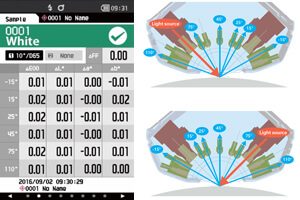The Challenges of Controlling Automotive Color and Appearance
The dynamic appearance of today’s leading auto brands is often created by using metallic or pearlescent finishes. These paints also create their own set of measurement challenges. Both paints contain aluminum or mica flakes that reflect light in different directions. Different reflection directions lead to variations in color and brightness levels depending on illumination and viewing settings. What this all means is the vehicle’s appearance depends on how you are observing it. A paint-coated surface that looks different, at different viewing angles, can only be measured and quality-controlled with a multi-angled instrument.
The commonalities between the two challenges? Their solutions. Both need multiple angles of measurement with a high measurement repeatability. Both need an instrument like the Spectrophotometer CM-M6. Equipped with a Ø12 mm aperture for measurement of 6mm, the CM-M6 features 6 aspecular viewing angles (-15°, 15°, 25°, 45°, 75°, 110°) that measure the various metallic and pearlescent paints colors as well as brightness levels produced by reflected light.
To eliminate the small spaces and uncovered gaps that result in unreliable color data, the CM-M6 has a built-in, patented double path illumination system that uses 2 symmetrical optical systems. This system compensates for any slight inclination to the instrument position during measurement, offering stable measurement results on a non-flat surface (i.e. radius> 300).











